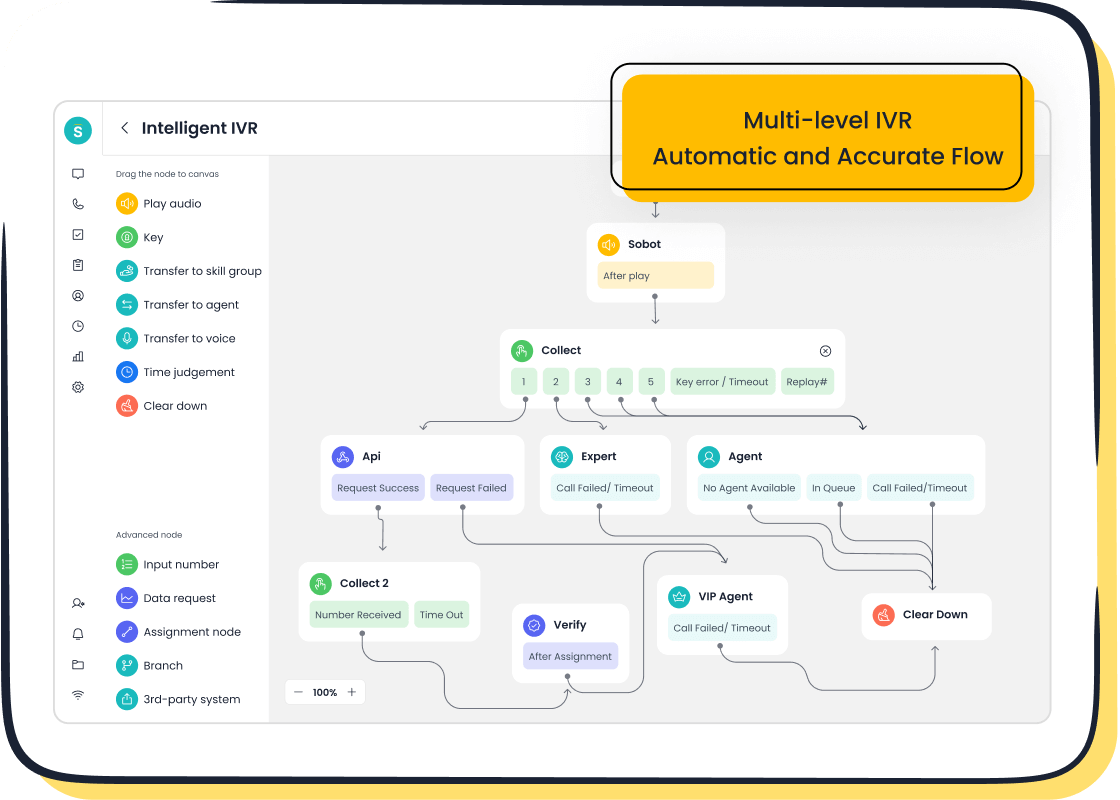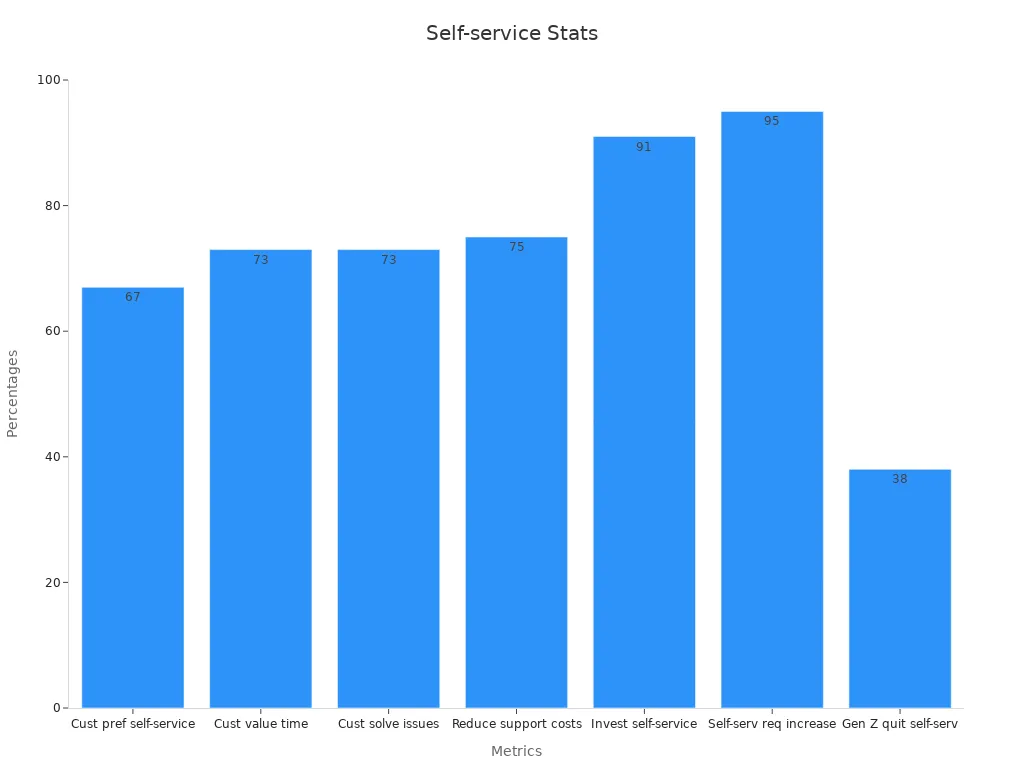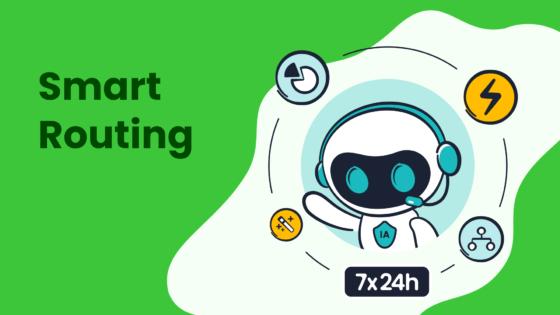Enterprise Cloud Contact Center: What Omnichannel Features Exist

In today’s fast-paced world, customers expect seamless communication across multiple platforms. This is where omnichannel features in an enterprise cloud contact center come into play. These features unify communication channels, allowing you to deliver consistent and personalized experiences. Meeting these expectations isn’t just a preference—it’s a necessity.
- 89% of customers stay loyal to businesses with strong omnichannel engagement.
- 9 out of 10 consumers demand seamless service across channels.
- 73% of customers will switch brands if consistency is lacking.
Adopting these solutions ensures you meet modern customer demands while building loyalty and trust. With Sobot’s innovative tools, you can enhance communication efficiency and satisfaction.
What Is an Enterprise Cloud Contact Center?
Definition and Core Purpose
An enterprise cloud contact center is a modern solution that enables businesses to manage customer interactions through cloud-based infrastructure. Unlike traditional systems, it eliminates the need for physical hardware, relying solely on internet connectivity. This approach simplifies operations and reduces costs, making it accessible to businesses of all sizes.
The core purpose of an enterprise cloud contact center is to unify communication channels, streamline workflows, and enhance customer experiences. It provides tools for managing voice calls, emails, social media messages, and live chats—all from a single platform. By leveraging advanced contact center software, you can deliver consistent service while improving operational efficiency.
💡 Tip: Cloud-based contact centers are ideal for businesses aiming to scale operations without investing heavily in physical infrastructure.
Key Features of Enterprise Cloud Contact Centers
Enterprise cloud contact centers offer a range of features designed to optimize customer service and agent productivity:
- Omnichannel Support: Manage interactions across multiple channels, ensuring seamless communication.
- AI Integration: Automate repetitive tasks and provide intelligent assistance to agents.
- Scalability: Adjust the number of agents based on demand, optimizing resources.
- Analytics and Reporting: Gain insights into performance metrics to improve decision-making.
- Remote Accessibility: Enable agents to work from anywhere, enhancing flexibility.
These features make cloud-based contact centers a preferred choice for businesses looking to enhance customer satisfaction and streamline operations.
Why Businesses Choose Enterprise Cloud Contact Centers
Businesses adopt enterprise cloud contact centers for their operational benefits and adaptability. The ability to scale operations, access advanced technology, and simplify infrastructure are key drivers. According to market data:
- Cloud-based contact centers improve transparency for customers using voice, video, and social media.
- The market is projected to grow significantly, with a CAGR of 25.43% expected during the forecast period.
- Nearly 70% of contact centers worldwide plan to continue remote work post-pandemic, highlighting the flexibility of cloud-based solutions.
| Benefit | Description |
|---|---|
| Simpler infrastructure and lower costs | Reduces the need for physical hardware and upfront investments, requiring only internet connectivity. |
| Improved scalability | Organizations can adjust the number of agents based on demand, optimizing costs and resources. |
| Access to new technology | Continuous updates and access to the latest features without needing to switch vendors. |
| Simpler upgrade process | Regular software upgrades are included in the service fee, minimizing service interruptions. |
| Easier remote work | Employees can work from anywhere with internet access, enhancing flexibility and productivity. |
By choosing contact center solutions like Sobot’s, you can future-proof your operations while delivering exceptional customer service.
Omnichannel Contact Center: Key Capabilities

What Is Omnichannel in Customer Service?
Omnichannel in customer service means creating a seamless and connected experience for your customers across all communication channels. Whether they reach out via email, social media, live chat, or phone, their journey remains consistent and personalized. This approach ensures that every interaction feels like part of a unified conversation, regardless of the platform.
| Definition of Omnichannel Customer Service | Measurable Benefits |
|---|---|
| A seamless and connected customer experience across multiple communication channels. | Improved customer satisfaction, loyalty, and retention; increased sales and conversions; greater agent productivity; enhanced brand reputation. |
By adopting an omnichannel contact center, you can deliver a higher level of service that meets modern customer expectations. This strategy not only enhances satisfaction but also builds trust and loyalty over time.
Omnichannel vs. Multichannel: A Comparison
It’s easy to confuse omnichannel with multichannel, but the two approaches differ significantly. Multichannel allows customers to interact with your business through various platforms, but these channels often operate independently. Omnichannel, on the other hand, integrates all channels to provide a cohesive and personalized experience.
- Omnichannel integrates and coordinates various channels for customer engagement.
- Multichannel uses multiple channels but lacks seamless integration.
- An omnichannel strategy unifies customer data and interactions across channels for a personalized experience.
- A multichannel strategy provides multiple communication options without connecting them.
- Omnichannel offers a richer and more consistent customer experience.
- Multichannel may lead to a less cohesive journey for customers.
When you choose an omnichannel contact center, you ensure that your customers enjoy a smooth and uninterrupted experience, no matter how they interact with your business.
How Omnichannel Enhances Customer Experience
An omnichannel contact center transforms the way you engage with your customers. By unifying communication channels, it allows you to provide faster, more personalized support. For example, if a customer starts a conversation on social media and later calls your support team, your agents can access the full context of their previous interactions. This continuity saves time and reduces frustration.
- Data-driven benchmarks help you align with industry trends and adopt best practices for omnichannel support.
- Cross-channel benchmarks ensure consistency, as customer expectations vary across communication platforms.
- Strategic planning and staffing during peak times become more efficient with data insights.
By leveraging these capabilities, you can elevate the customer experience while improving operational efficiency. An omnichannel approach not only meets customer demands but also positions your business as a leader in service excellence.
Omnichannel Features in Enterprise Cloud Contact Centers
Omnichannel Routing and Contextual Transfers
Omnichannel routing ensures that customer interactions are directed to the most suitable agent or department. This feature uses intelligent algorithms to analyze factors like agent expertise, customer history, and current workloads. By doing so, it minimizes wait times and improves first-contact resolution rates. For example, if a customer starts a conversation on live chat and later calls the support line, omnichannel routing ensures the agent handling the call has access to the full interaction history. This seamless transition, known as contextual transfer, eliminates the need for customers to repeat themselves.
| Performance Metric | Description |
|---|---|
| Improved agent productivity | Omnichannel routing directs interactions to the best-suited agents, enhancing efficiency. |
| Decreased average wait times | Smart routing connects customers quickly, reducing frustration and abandonment rates. |
| Reduced average handle times | Issues are resolved faster by routing to the most qualified agents, minimizing call duration. |
| Higher customer satisfaction | Direct connections to available agents improve first-contact resolution and overall satisfaction. |
| Unified customer view | Agents access complete interaction histories for personalized support. |

Businesses using omnichannel routing report fewer call transfers and higher customer satisfaction. Sobot’s omnichannel contact center integrates all communication channels into a single platform, enabling agents to manage inquiries efficiently. This unified approach ensures consistent service across a wide range of supported channels, from voice to social media.
AI-Powered Assistance and Automation
AI-powered assistance transforms how you handle customer interactions. Intelligent virtual assistants (IVAs) and chatbots provide 24/7 support, allowing customers to resolve issues independently. This reduces the workload on agents and improves first-contact resolution rates. For instance, Sobot’s AI-powered Voicebot uses intent recognition to guide customers through self-service options, ensuring faster resolutions.
AI also enhances agent performance. Real-time support tools analyze conversations and provide agents with immediate feedback. This helps them respond more effectively, improving customer satisfaction. Additionally, AI tools summarize interactions, automate repetitive tasks, and offer expert advice, enabling agents to focus on complex issues.
Did you know? AI-driven automation can reduce idle time for agents and improve response times, fostering customer loyalty and reducing turnover costs.
Sobot’s omnichannel contact center leverages AI to optimize workflows and enhance customer experiences. By integrating AI-powered features, you can deliver faster, more personalized service while reducing operational costs.
Real-Time Insights and Analytics
Real-time analytics provide actionable insights into customer interactions and agent performance. These tools monitor key performance indicators (KPIs) like average handle time, customer satisfaction scores, and first-contact resolution rates. For example, custom dashboards allow you to track trends and make data-driven decisions instantly.
| Tool Name | Key Features | Benefits |
|---|---|---|
| Genesys Cloud | Predictive analytics, AI-driven insights | Immediate feedback on customer interactions, trend analysis over time |
| LiveAgent | Comprehensive reporting capabilities | Real-time visualization of ROI, swift access to performance metrics |
| Custom Dashboards | Tailored interfaces for specific KPIs | Instant access to critical information, enhances strategic decision-making |
Sobot’s omnichannel contact center includes advanced analytics tools that consolidate data from all channels. This unified view helps you understand customer behavior and optimize resource allocation. By leveraging these insights, you can improve service quality and enhance customer satisfaction.
Self-Service Options and Chatbots
Self-service options empower your customers to resolve issues independently, saving time and enhancing satisfaction. Chatbots play a crucial role in this process by providing instant responses and guiding users through common queries. These tools reduce the workload on your agents, allowing them to focus on complex problems.
For example, Sobot’s AI-powered chatbot offers multilingual support and 24/7 availability. It uses advanced algorithms to understand customer intent and provide accurate solutions. This feature ensures that your customers receive timely assistance, even outside business hours.
💡 Did you know? Over 67% of customers prefer self-service options over speaking to a representative.
Why Self-Service Matters
Customers value speed and convenience. Self-service options cater to these preferences by offering quick resolutions without the need for human intervention. Chatbots enhance this experience by delivering personalized support based on customer data.
| Statistic | Value |
|---|---|
| Percentage of customers preferring self-service over speaking to agents | 67% |
| Customers valuing time as the most important factor from a company | 73% |
| Expected growth of the global self-service technology market | 14% CAGR to reach $92 billion |
| Customers wanting the ability to solve issues independently | 73% |
| Potential reduction in support costs through digital self-service | 75% |
| Companies identifying self-service as a relevant investment focus | 91% |
| Businesses witnessing an increase in self-service requests | 95% |
| Gen Z and Millennial customers giving up on issues if not resolved via self-service | 38% |

Sobot’s omnichannel contact center integrates self-service options seamlessly into your customer support strategy. By adopting these features, you can reduce operational costs by up to 75% while improving customer satisfaction.
Integration with CRM and Other Tools
Integrating your CRM system with an omnichannel contact center unlocks new possibilities for personalized service. This integration ensures that your agents have access to complete customer profiles, enabling them to deliver tailored solutions.
Sobot’s omnichannel solutions offer native integrations with popular CRM platforms like Salesforce and Shopify. These integrations streamline workflows by automating data management and reducing errors. For instance, when a customer contacts your support team, the system retrieves their purchase history and previous interactions. This unified view allows your agents to respond effectively, enhancing the overall experience.
| Benefit | Description |
|---|---|
| Improved Customer Satisfaction | Personalized interactions lead to higher customer satisfaction and loyalty. |
| Operational Efficiency | Automation of data management and streamlined workflows reduce handling times and errors. |
| Enhanced Communication | Unified information allows agents to respond effectively, improving overall customer experience. |
📈 Pro Tip: Businesses that integrate CRM systems with their contact centers report higher customer satisfaction rates and improved operational efficiency.
Sobot’s integration capabilities simplify this process, ensuring that your systems work together seamlessly. By leveraging these features, you can optimize your omnichannel strategy and deliver exceptional service across all channels.
Benefits of Omnichannel Support for Businesses

Improved Customer Satisfaction and Loyalty
Omnichannel contact centers transform how you engage with customers by creating seamless experiences across all communication channels. When customers can switch between platforms without losing context, they feel valued and understood. This approach not only enhances customer satisfaction but also builds long-term loyalty. For instance, a study by Harvard Business Review revealed that 73% of shoppers prefer businesses offering both online and offline experiences. This highlights the importance of a unified strategy in meeting customer expectations.
Metrics like Customer Satisfaction Score (CSAT) and Net Promoter Score (NPS) further demonstrate the impact of omnichannel support. These tools measure how satisfied customers are and how likely they are to recommend your brand. By integrating omnichannel solutions like Sobot’s, you can improve these scores significantly. Sobot’s unified platform ensures consistent service across channels, helping you retain customers and boost loyalty.
| Metric | Description |
|---|---|
| Customer Satisfaction Score (CSAT) | Measures customer satisfaction on a scale, typically from 1 to 5 or 1 to 10, based on survey responses. |
| Net Promoter Score (NPS) | Indicates how likely customers are to recommend the brand, derived from specific survey questions. |
| Customer Lifetime Value (CLV) | Represents the total value a customer brings to the company over their relationship with the brand. |
| Customer Loyalty Index | Assesses customer loyalty based on factors like retention rate and average order value. |
Enhanced Agent Productivity and Efficiency
Omnichannel contact centers empower your agents to work smarter, not harder. By consolidating customer data into a single interface, agents can access complete interaction histories. This reduces the time spent searching for information and allows them to focus on resolving issues efficiently. For example, Sobot’s omnichannel platform provides a unified workspace where agents can manage calls, emails, and chats seamlessly.
Key performance indicators (KPIs) like First Contact Resolution (FCR) and Average Handle Time (AHT) highlight the productivity gains from omnichannel solutions. With intelligent routing and AI-powered tools, agents can resolve issues faster and more effectively. This not only improves customer satisfaction but also reduces operational costs.
| KPI | Description |
|---|---|
| First Contact Resolution | Percentage of customer issues resolved in the initial interaction, indicating high productivity. |
| Average Handle Time | Average time taken by an agent to handle an interaction, including hold and after-call work. |
| Customer Satisfaction | Scores derived from surveys or feedback forms, reflecting customer contentment with service. |
| Average Speed of Answer | Time taken for an agent to answer a call, impacting customer experience. |
| Abandonment Time | Duration before a customer hangs up, which can indicate service efficiency. |
Scalability and Flexibility for Growth
Cloud-based omnichannel contact centers offer unmatched scalability, allowing you to adapt to changing business needs. Whether you face seasonal demand spikes or sudden surges in customer inquiries, cloud solutions enable real-time resource adjustments. For example, a DMV contact center managed high call volumes during peak periods by transitioning to a cloud-based system. This flexibility reduced wait times and improved service quality.
Sobot’s cloud solutions provide a pay-as-you-go model, making it easier to scale operations without incurring unnecessary costs. This approach eliminates the need for permanent infrastructure, ensuring your business remains agile and cost-effective. By adopting an omnichannel strategy, you can future-proof your operations and support growth seamlessly.
Pro Tip: Scalability ensures you can handle unexpected demand without compromising customer satisfaction or service quality.
Data-Driven Decision Making and Insights
Data-driven decision-making transforms how you approach customer service. By leveraging insights from omnichannel analytics, you can make informed choices that improve efficiency, enhance customer experiences, and drive business growth.
Omnichannel analytics consolidates data from multiple sources, giving you a comprehensive view of customer interactions. This unified perspective helps you identify trends, understand preferences, and tailor your services. For example, LaFleur Marketing used omnichannel analytics to merge data from various platforms. They overcame challenges like duplicate IDs and scattered information, turning it into actionable insights for their clients. This approach enabled better analysis and more effective decision-making.
With these tools, you can also optimize operations. Analytics can reveal high-traffic areas, helping you choose the best locations for new stores or service centers. For instance, footfall data can guide decisions on where to open a restaurant, ensuring maximum visibility and customer engagement. Additionally, personalized marketing becomes easier when you use diverse data points. Tailoring your campaigns based on customer behavior fosters loyalty and increases engagement.
Here’s how omnichannel analytics benefits your business:
- Enhanced Efficiency: Streamlines processes, saving time and effort.
- Better Customer Experience: Reveals preferences, enabling tailored communication.
- Informed Decision-Making: Provides a well-rounded view of data for strategic planning.
| Benefit | Example |
|---|---|
| Location Insights | Identifies high-traffic areas for new sites. |
| Personalized Marketing | Uses customer data to create targeted campaigns. |
| Unified Customer Experience | Ensures seamless interactions across all channels. |
By adopting data-driven strategies, you can deliver a unified customer experience. This approach not only improves satisfaction but also builds long-term loyalty. With tools like Sobot’s omnichannel solutions, you gain the insights needed to stay ahead in a competitive market.
Implementing Omnichannel Cloud Contact Center Solutions
Integration with Existing Systems
Integrating an omnichannel cloud contact center with your existing systems can seem challenging, but it’s a critical step for success. Modernizing your IT infrastructure ensures seamless communication and operational efficiency. For example, a retail company integrated its legacy POS system with a cloud-based payment gateway and an e-commerce platform using iPaaS. This approach automated workflows, eliminated redundant tasks, and enhanced customer experiences by enabling personalized interactions.
To achieve similar results, focus on compatibility and scalability. Choose a solution that works with your CRM, ERP, or other tools. Sobot’s omnichannel platform offers native integrations with popular systems like Salesforce and Shopify, simplifying this process. By connecting your systems, you can unify customer data, streamline workflows, and improve service quality.
Tip: Start small by integrating one system at a time. This minimizes disruptions and ensures a smoother transition.
Training Agents for Omnichannel Proficiency
Your agents play a vital role in delivering exceptional customer experiences. Training them for omnichannel proficiency equips them to handle diverse interactions effectively. Tailored training programs, such as performance evaluations and continuous feedback loops, can significantly enhance their skills.
| Methodology | Description |
|---|---|
| Performance Evaluations | Focuses on individual agent needs to improve service quality. |
| Integration of Technology | Uses real-time analytics to monitor performance and refine training. |
| Continuous Feedback Loops | Provides ongoing adjustments to training, ensuring better customer outcomes. |
These methods lead to higher customer satisfaction, increased agent engagement, and improved problem-solving abilities. For instance, agents trained with Sobot’s unified workspace can access complete customer histories, enabling faster resolutions. This approach aligns with the best practices for incorporating omnichannel strategies into your operations.
Pro Tip: Use role-playing scenarios to simulate real-world interactions. This helps agents build confidence and adaptability.
Ensuring Data Security and Compliance
Data security is a top priority when implementing an omnichannel contact center. Compliance with industry standards protects customer information and builds trust. Certifications like PCI DSS for payment security and GDPR for data privacy ensure your operations meet global requirements.
| Compliance Standard | Description |
|---|---|
| PCI DSS | Ensures secure payment card processing. |
| GDPR | Protects customer data and privacy in the EU. |
| ISO-27001 | Certifies robust information security management. |
Sobot’s solutions adhere to these standards, offering encrypted data transfer and secure integrations. Regular audits and compliance checks further strengthen your security framework. By prioritizing these measures, you can safeguard sensitive information while delivering a seamless omnichannel experience.
Did you know? Companies that prioritize compliance see higher customer retention rates due to increased trust.
Measuring Success Through KPIs and Feedback
Tracking the success of your omnichannel contact center requires clear metrics and actionable feedback. Key performance indicators (KPIs) provide measurable insights into how well your system meets customer expectations. By monitoring these metrics, you can identify strengths, address weaknesses, and continuously improve your service.
| Metric | Description |
|---|---|
| Customer Satisfaction (CSAT) | Measures how satisfied customers are with a company's products, services, or experiences. |
| Average Response Time | Indicates how quickly the support team responds to customer inquiries across all channels. |
| First Contact Resolution (FCR) | Percentage of customer issues resolved upon the first interaction, reflecting responsiveness and effectiveness. |
| Channel Efficiency | Evaluates performance of each support channel, analyzing interactions, resolution times, and customer satisfaction. |
| Customer Effort Score (CES) | Assesses the ease of issue resolution through support channels, indicating customer experience quality. |
| Net Promoter Score (NPS) | Evaluates customer loyalty and satisfaction, helping businesses identify areas for improvement. |
Each metric offers unique insights. For example, CSAT and NPS reveal how customers perceive your brand. High scores indicate satisfaction and loyalty, while low scores highlight areas needing attention. FCR and Average Response Time measure operational efficiency. Faster resolutions and first-contact success often lead to happier customers. CES focuses on the effort customers must exert to resolve issues. Lower effort scores suggest a smoother experience.
Feedback complements KPIs by adding context to the numbers. Surveys, reviews, and direct comments help you understand customer pain points. For instance, if NPS drops, feedback can reveal whether slow response times or inconsistent service caused dissatisfaction. Use this information to refine your processes.
By combining KPIs with customer feedback, you gain a complete picture of your contact center’s performance. This approach ensures you meet customer expectations while driving continuous improvement. Tools like Sobot’s omnichannel solutions simplify tracking these metrics, helping you deliver exceptional service every time.
Omnichannel capabilities redefine customer service in enterprise cloud contact centers. They unify communication channels, ensuring seamless experiences that boost satisfaction and loyalty. Businesses gain a competitive edge by integrating systems, enabling agents to access complete customer histories. Real-time analytics further enhance decision-making, driving continuous improvement.
| Benefit | Description |
|---|---|
| Seamless Omnichannel Experience | Provides a unified customer experience across various channels, enhancing customer satisfaction and loyalty. |
| Enhanced Integration Capabilities | Syncs data from different systems to create a cohesive experience, giving agents full context of customer interactions. |
| Improved Real-Time Analytics | Offers dashboards and reporting tools that help identify performance metrics and drive strategic improvements. |
Sobot’s solutions, including its Voice/Call Center, empower you to deliver exceptional service. With features like AI-powered automation and global scalability, Sobot helps you meet customer expectations effortlessly. Adopting omnichannel strategies ensures your business stays competitive and ready for future growth. Explore Sobot’s offerings to transform your customer service journey.
FAQ
What is the difference between omnichannel and multichannel contact centers?
Omnichannel contact centers integrate all communication channels into a unified system, ensuring seamless customer experiences. Multichannel contact centers, however, operate channels independently, often leading to fragmented interactions. Omnichannel solutions provide continuity and personalization, while multichannel systems lack integration.
How does AI improve customer service in omnichannel contact centers?
AI enhances customer service by automating repetitive tasks, providing instant responses, and analyzing customer data. Tools like chatbots and voice assistants offer 24/7 support, while AI-driven insights help agents deliver personalized solutions. This improves efficiency and customer satisfaction.
Can omnichannel contact centers handle high call volumes?
Yes, omnichannel contact centers manage high call volumes effectively. Features like intelligent routing, self-service options, and AI-powered automation reduce wait times and distribute workloads efficiently. These tools ensure smooth operations during peak periods.
Why is CRM integration important in omnichannel contact centers?
CRM integration centralizes customer data, enabling agents to access complete interaction histories. This improves personalization and reduces resolution times. Integrated systems streamline workflows, enhance communication, and boost customer satisfaction.
How do omnichannel solutions benefit small businesses?
Omnichannel solutions offer scalability, cost-efficiency, and advanced tools like AI and analytics. Small businesses can provide professional, seamless customer experiences without investing in extensive infrastructure. These solutions help build trust and loyalty, driving growth.
See Also
Essential Tips for Choosing Omnichannel Call Center Tools
A Comprehensive Guide to Deploying Omnichannel Contact Centers
Best Reviewed Cloud Contact Center Services for 2024
